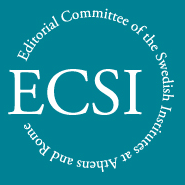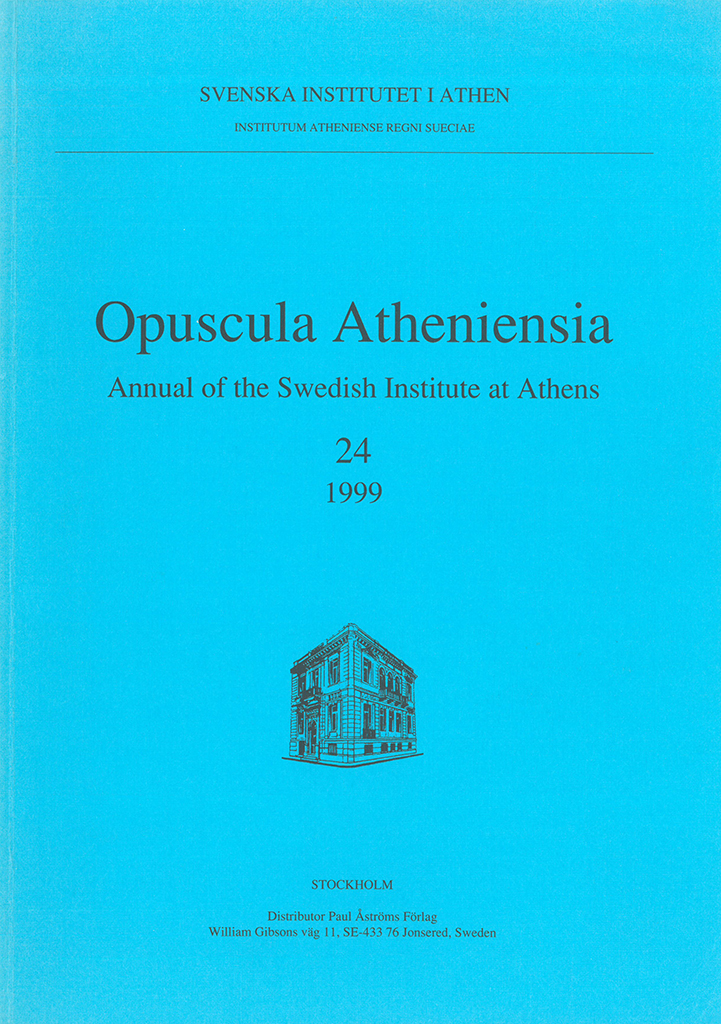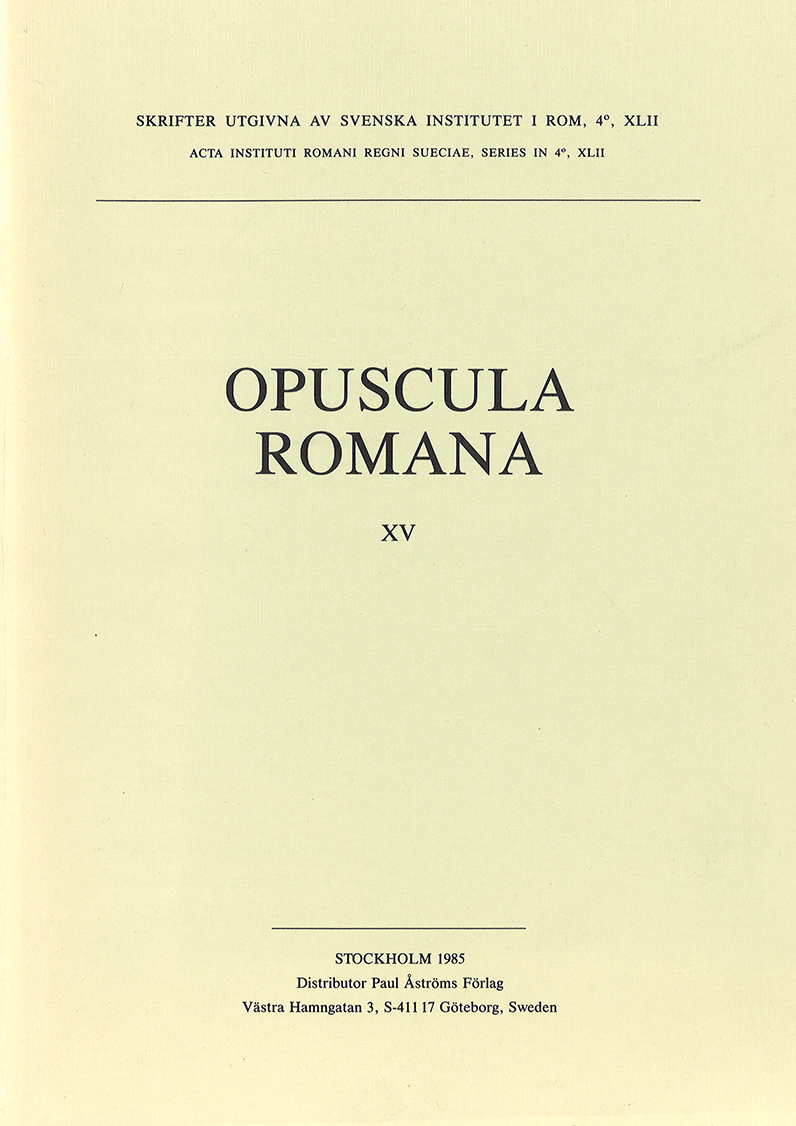Published by the Swedish Institute at Athens. Distributed by Astrom Editions. Opuscula Atheniensia. Annual of the Swedish Institute at Athens 24, 1999 Contents Donald W. Jones, ‘The archaeology and economy of Homeric gift exchange’ Donald W. Jones, ‘The conundrum of Greek population growth in the 8th century B.C. Burials, settlements, and wells’ Jane F. Lloyd, ‘The three-dimensional form of the light area of the Minoan hall system and the southeast corner of the South Hous at Knossos’ Jari Pakkanen, ‘Defining the possible column shaft height range and profile. A case study based on the temple of Zeus at Labraunda’ Eva Rystedt, ‘No words, only pictures. Iconography in the transition between the Bronze Age and the Iron Age in Greece’ Zofia Stos-Gale, Maria Kayafa & Noel Gale, ‘The origin of metals from the Bronze Age site of Nichoria’ Lars Walløe, ‘Was the disruption of the Mycenaean world caused by repeated epidemics of bubonic plague?’ Book reviews Jeannette Forsén, ‘E. Christmann, Die Deutschen Ausgrabungen auf der Pevkakia-Magula in Thessalien II. Die Frühe Bronzezeit’ Jeannette Forsén, ‘J.B. Rutter, Lerna III. The pottery of Lerna IV‘ Michael Wedde, ‘K. Sbonias, Frühkretische Siegel. Ansätze für eine Interpretation der sozialpolitischen Entwicklung auf Kreta während der Frühbronzezeit’ Ann-Louise…
Published by the Swedish Institute of Classical Studies in Rome. Distributed by Astrom Editions. Opuscula Romana 15 Contents Patrikk Bruun, ‘From polis to metropolis. Notes on Thessalonica in the administration of the Late Roman Empire´, pp. 7–16. Lucos Cozza, ‘La grande pianta di Falerii esposta nel museo di Villa Giulia’, pp. 17–46. Ingrid Edlund, ‘A terracotta head from Poggio Civitate (Murlo)’, pp. 47–53. Harry Erkell, ‘Varroniana II. Studi topografici in Varro, De lingua Latina V, §§45–50’, pp. 55–65. Hack Kampmann, ‘The ustrinum in Palazzo del Parlamento in Rome’, pp. 67–78. John Kraft, ‘The Cretan Labyrinth and the walls of Troy. An analysis of Roman labyrinth designs’, pp. 79–86. Anne-Marie Leander Touati, ‘A marble head in the Swedish Institute in Rome’, pp. 87–92. Hugo Montgomery, ‘Decurion and clergy—some suggestions’, pp. 93–95. Eva Rystedt, ‘An unusual Etruscan vase from Chiusi’, pp. 97–104. Charlotte Scheffer, ‘Was there a garden at Poggio Civitate?’, pp. 105–108. Bengt E. Thomasson, ‘Zur Laufbahn einiger Statthalter des Prinzipats’, pp. 109–141. David Whitehouse, ‘Medieval pottery from Luni sul Mignone’, pp. 143–147. Örjan Wikander, ‘Mill channels, weirs and ponds. The environment of ancient watermills’, pp. 149–154. Örjan Wikander, ‘Senators and equites. I. The case of the Aufidii’, pp. 155–63. Guide…
Published by the Swedish Institute at Athens. Distributed by Astrom Editions. Gedanke und Tat. Zur Erzählungstechnik bei Herodot, Thukydides, Xenophon und Arrian By Hugo Montgomery Inhalt I. Herodot A. Einleitung B. Formen seelischer Vorgänge, denen Herodot Bedeutung für eine Handlung beimisst C. Anwendung und Vorkommen der Aussagen über seelische Vorgänge D. Geschichtlichkeit E. Die Arbeitsweise Herodots F. Ziel und Sinn der seelischen Begründungen G. Schlusswort II. Thukydides A. Einleitung B. Formen seelischer Vorgänge, denen Thukydides Bedeutung für eine Handlung Beimisst C. Vergleich der Schilderungen seelischer Vorgänge bei Thukydides und Herodot D. Vorkommen und Anwendung der Aussagen über seelische Vorgänge E. Geschichtlichkeit F. Die Arbeitsweise des Thukydides G. Schlusswort III. Xenophon Einleitung Hellenica A. Seelische Vorgänge, denen Xenophon Bedeutung für eine Handlung beimisst B. Ziel und Sinn der Darstellung seelischer Vorgänge C. Transzendentale Geschichtsauffassung Anabasis A. Seelische Vorgänge, denen Xenophon Bedeutung für eine Handlung beimisst B. Zurückhaltung Xenophons bei der seelischen Motivation C. Darstellung der eigenen seelischen Aktivität Xenophons Cyropaedia A. Einleitung B. Seelische Vorgänge, denen Xenophon Bedeutung für Kyros‘ Handeln beimisst C. Motivierung der Handlungen anderer Personen Zusammenfassung A. Anwendung und Vorkommen der Aussagen über seelische vorgänge B. Geschichtlichkeit C. Die Arbeitsweise Xenophons D. Quellenwert E. Schlusswort IV. Arrian A….


